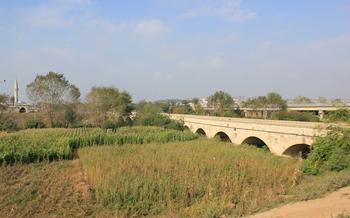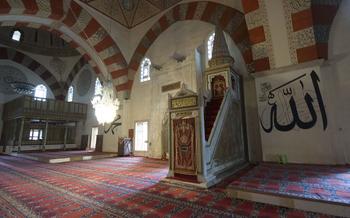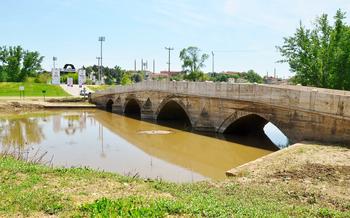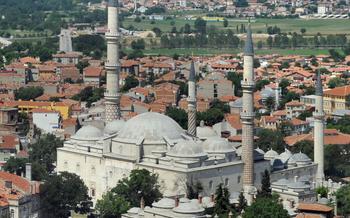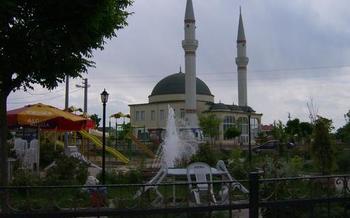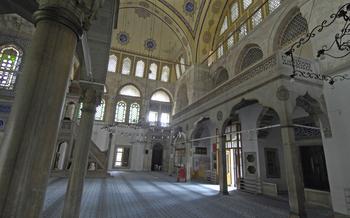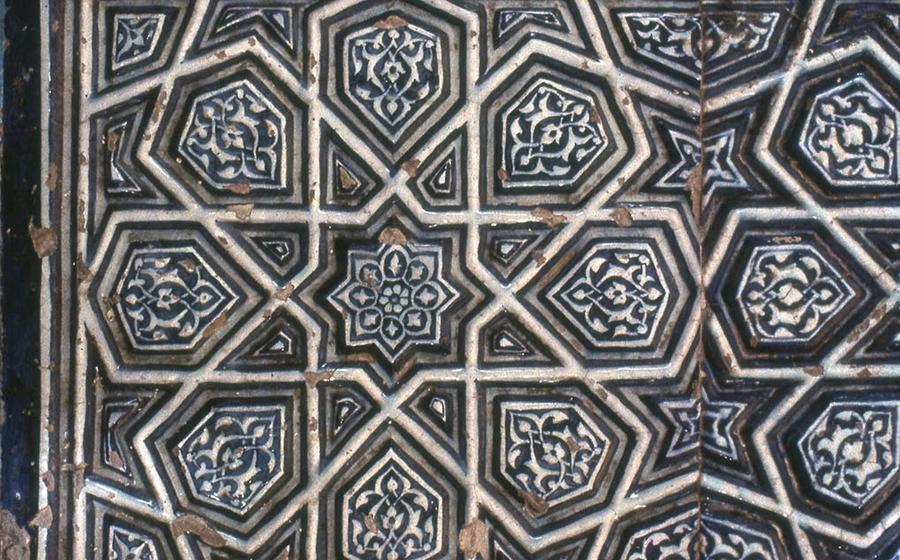
Muradiye Mosque
- Historical Significance
- Architectural Marvel
- Prayer Hall Serenity
- Courtyard Oasis
- Madrasa Exploration:
- Historical Context
- Minaret Majesty
- Tilework Masterpieces
- Calligraphy Elegance
- Restoration Efforts
- Sultan's Tomb
- Local Legends and Folklore
- Prayer Times and Etiquette:
- Photography Tips
- Insider's Tips for an Enriching Experience:
Historical Significance
The Muradiye Mosque stands as a testament to the rich history and architectural prowess of the Ottoman Empire. Built in the 15th century by Sultan Murad II, the mosque showcases a harmonious blend of Ottoman and Byzantine influences, reflecting the empire's cultural diversity and power. As you explore its intricate tilework, elegant domes, and soaring minarets, you'll be transported back in time, immersing yourself in the stories and legends that surround this iconic landmark. Discover the mosque's role as a symbol of Ottoman authority and its enduring significance to the city of Edirne.
Architectural Marvel
The Muradiye Mosque stands as a testament to the architectural brilliance of the Ottoman Empire. Its stunning facade, adorned with intricate tilework and elegant domes, captivates the eye from afar. As you approach the mosque, the vast courtyard, with its marble columns and arches, leads you to the main prayer hall, a spacious and awe-inspiring space. The interior of the mosque is a symphony of Islamic and Byzantine architectural elements, showcasing the cultural diversity of the Ottoman Empire. Marvel at the intricate carvings and calligraphy that adorn the walls, each stroke a testament to the skill and artistry of Ottoman craftsmen. The unique blend of architectural styles creates a harmonious and visually stunning masterpiece, a true architectural marvel that reflects the grandeur and power of the Ottoman Empire.
Prayer Hall Serenity
Step inside the main prayer hall, a spacious and tranquil space adorned with intricate carpets and chandeliers. Experience the spiritual atmosphere as you observe worshippers engaged in prayer and devotion. Admire the stunning mihrab, a niche indicating the direction of Mecca, adorned with colorful tiles and intricate calligraphy. Reflect on the mosque's significance as a place of worship and a center for the Muslim community in Edirne. The serene ambiance of the prayer hall invites contemplation and reflection, allowing visitors to connect with the spiritual essence of the mosque.
Courtyard Oasis
In the heart of the bustling city, the Muradiye Mosque offers a tranquil refuge within its serene courtyard. As you step inside, the courtyard's lush greenery and the gentle sound of water fountains create an oasis of peace and tranquility. Relax under the shade of trees, surrounded by intricate tilework and carvings adorning the courtyard's walls. Take a moment to appreciate the artistic prowess of Ottoman artisans as you wander through this tranquil space. Engage in conversations with fellow visitors, fostering a sense of community and sharing stories about the mosque's rich history and significance. The courtyard serves as a reminder of the harmonious coexistence of nature and architecture, inviting visitors to pause, reflect, and appreciate the beauty that surrounds them.
Madrasa Exploration:
Venture into the adjacent madrasa, an Islamic school that was once an integral part of the Muradiye Mosque complex. Explore the madrasa's classrooms, where students from various backgrounds studied Islamic subjects under the guidance of renowned scholars. Learn about the madrasa's educational system and curriculum, providing insights into the intellectual and religious life of the Ottoman Empire. Admire the architectural features of the madrasa, complementing the overall design of the Muradiye Mosque complex. Discover the rich history and legacy of Islamic education within the walls of this historic institution.
Historical Context
The construction of the Muradiye Mosque was deeply rooted in the historical context of the Ottoman Empire. Sultan Murad II, who ruled from 1421 to 1451, embarked on an ambitious building program throughout his reign, leaving a lasting legacy of architectural masterpieces. The decision to build the Muradiye Mosque in Edirne, then the capital of the empire, was a strategic move that reflected the city's political and cultural significance.
Edirne, located in northwestern Turkey, held a pivotal position in the Ottoman Empire's expansion towards Europe. It served as a military stronghold and a gateway to the Balkans, providing easy access to the empire's newly conquered territories. By constructing the Muradiye Mosque in Edirne, Sultan Murad II aimed to solidify the city's status as a prominent center of Islamic faith and culture, reinforcing the empire's authority and influence in the region.
The mosque's construction also coincided with a period of relative peace and prosperity in the Ottoman Empire. Sultan Murad II's successful campaigns against neighboring states had secured the empire's frontiers, allowing him to focus on domestic affairs and the development of infrastructure. The construction of the Muradiye Mosque, along with other architectural projects, reflected the empire's growing wealth and power, as well as its commitment to promoting Islamic values and traditions.
Minaret Majesty
Ascend the towering minarets of the Muradiye Mosque, embarking on a journey to the heavens. These majestic structures, reaching towards the sky, offer breathtaking panoramic views of Edirne and the surrounding countryside. Marvel at the intricate tilework and decorative elements adorning the minarets, showcasing the architectural prowess of Ottoman builders. Experience the thrill of being at the highest point of the mosque, evoking a sense of awe and wonder. Capture stunning photographs of the city's skyline, creating lasting memories of your visit to the Muradiye Mosque.
Tilework Masterpieces
The Muradiye Mosque is renowned for its exquisite tilework, which adorns both the interior and exterior of the building. These intricate tiles, known as çini in Turkish, are a hallmark of Ottoman architecture and showcase the skill and artistry of Ottoman craftsmen. The tiles feature vibrant colors, geometric patterns, and floral motifs, creating a mesmerizing visual spectacle.
One of the most striking features of the mosque's tilework is the mihrab, a niche indicating the direction of Mecca. The mihrab is adorned with colorful tiles arranged in a symmetrical pattern, creating a stunning focal point within the prayer hall. The tiles depict verses from the Quran and sayings of the Prophet Muhammad, adding to the mosque's spiritual significance.
The tilework on the mosque's exterior is equally impressive, featuring intricate geometric patterns and floral designs. The tiles are arranged in bands and panels, creating a harmonious and visually appealing composition. The tiles' vibrant colors, which include shades of blue, green, and red, contrast beautifully with the mosque's whitewashed walls.
The tilework of the Muradiye Mosque is not merely decorative but also carries symbolic and religious significance. The geometric patterns represent the order and harmony of the universe, while the floral motifs symbolize the beauty and diversity of creation. The tiles' vibrant colors are believed to evoke a sense of joy and spirituality, enhancing the mosque's sacred atmosphere.
Calligraphy Elegance
The Muradiye Mosque is not only a testament to architectural prowess but also a showcase of exquisite calligraphy, a revered art form in Islamic culture. The walls and mihrab of the mosque are adorned with elegant Arabic script, meticulously crafted by skilled calligraphers. Verses from the Quran and sayings of the Prophet Muhammad are inscribed in intricate patterns, adding to the mosque's overall spiritual ambiance.
Calligraphy holds immense significance in Islamic art and architecture, serving as a visual expression of faith and devotion. The calligraphers who worked on the Muradiye Mosque demonstrated their mastery of this art form, creating inscriptions that are both aesthetically pleasing and deeply meaningful. The precise brushstrokes and harmonious compositions evoke a sense of awe and reverence.
As you admire the calligraphy at the Muradiye Mosque, take a moment to appreciate the skill and dedication required to create such intricate works of art. Each letter, each stroke, is carefully executed, conveying a profound message. The inscriptions not only beautify the mosque but also serve as a reminder of the enduring power of the written word in Islamic culture.
Restoration Efforts
Over the centuries, the Muradiye Mosque has faced the inevitable effects of time, wear, and environmental factors. Recognizing the mosque's historical and cultural significance, ongoing restoration efforts aim to preserve its integrity and architectural beauty for future generations.
These efforts involve a meticulous process that requires expertise in conservation and restoration techniques. Skilled artisans and conservators carefully assess the mosque's condition, identifying areas that require attention. They use traditional materials and methods to restore damaged elements, ensuring authenticity and preserving the mosque's original character.
The restoration process often includes cleaning and repairing the mosque's exterior and interior surfaces, addressing issues such as cracks, fading paint, and deteriorating tiles. Additionally, structural reinforcements may be necessary to ensure the mosque's stability and longevity.
By undertaking these restoration efforts, the authorities and conservationists demonstrate their commitment to safeguarding this precious cultural heritage. Their dedication ensures that the Muradiye Mosque continues to stand as a testament to the architectural achievements of the Ottoman Empire and a symbol of Edirne's rich history.
Sultan's Tomb
Nestled within the hallowed grounds of the Muradiye Mosque complex lies the türbe, or tomb, of Sultan Murad II, a revered figure in Ottoman history. Pay homage to the sultan whose reign marked a significant era of conquest, administrative reforms, and patronage of the arts and sciences. Learn about his accomplishments and legacy, which left an indelible mark on the empire's trajectory. Reflect on the transience of power and the enduring impact of Sultan Murad II's rule as you stand before his final resting place, a testament to his contributions to the Ottoman legacy.
Local Legends and Folklore
Enrich your visit to the Muradiye Mosque by delving into the captivating realm of local legends and folklore that surround this sacred site. Engage with friendly locals, eager to share tales of miracles, mystical occurrences, and spiritual encounters associated with the mosque. These stories, passed down through generations, offer a glimpse into the cultural and religious identity of the Edirne community. Discover how these legends have shaped the mosque's significance beyond its architectural grandeur, adding a layer of intrigue and enchantment to your exploration.
Prayer Times and Etiquette:
Before visiting the Muradiye Mosque, familiarizing yourself with the prayer times is essential to witness the vibrant spiritual atmosphere during daily prayers. Respect the mosque's etiquette and dress code by dressing modestly and behaving respectfully. Observe the rituals and customs associated with Islamic prayer, gaining insights into the religious practices of the Muslim community. If you wish, participate in the communal prayers to foster a sense of unity and understanding among worshippers. Remember that the mosque is a place of worship, so maintain silence and avoid disturbing those engaged in prayer.
Photography Tips
Capture the beauty of the Muradiye Mosque through photography, preserving memories of your visit. Experiment with different angles and perspectives to showcase the mosque's architectural details, grandeur, and surroundings. Utilize natural lighting conditions to enhance the colors and textures of the mosque's exterior and interior. Share your photographs with friends, family, and fellow travelers, inspiring them to explore this magnificent landmark.
Insider's Tips for an Enriching Experience:
-
Early Morning or Late Afternoon Serenity: Plan your visit to the Muradiye Mosque during the early morning or late afternoon hours to escape the midday heat and crowds. This tranquil atmosphere will allow you to fully appreciate the mosque's beauty and grandeur without distractions.
-
Explore Edirne's Historic Treasures: Take advantage of the mosque's proximity to other historical landmarks in Edirne. Create a comprehensive itinerary that includes visits to the Selimiye Mosque, a masterpiece of Ottoman architecture, and the Edirne Palace, a former imperial residence.
-
Enrich Your Understanding with Guided Tours: Engage with local guides or participate in guided tours to gain deeper insights into the mosque's history, architecture, and cultural significance. These knowledgeable guides will provide fascinating anecdotes and explanations, enhancing your overall experience.
-
Savoring Local Delights: Immerse yourself in the culinary delights of Edirne by trying traditional Turkish dishes at nearby restaurants. Savor the flavors of regional specialties like Thracian pide, a delicious flatbread with various toppings, and keşkek, a hearty dish made from wheat, meat, and yogurt.

